United States Astronaut Hall of Fame
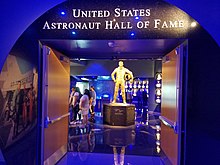
The United States Astronaut Hall of Fame, located inside the
in 1966.History
In the 1980s, the six then-surviving
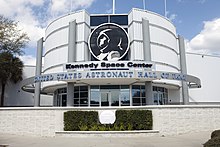
The Astronaut Hall of Fame was opened on October 29, 1990, by the U.S. Space Camp Foundation, which was the first owner of the facility. It was located next to the Florida branch of
The Hall of Fame closed for several months in 2002 when U.S. Space Camp Foundation's creditors foreclosed on the property due to low attendance and mounting debt.
The Hall of Fame, which was originally located just west of the NASA Causeway, closed to the public on November 2, 2015, in preparation for its relocation to the Kennedy Space Center Visitor Complex 6 miles (9.7 km) to the east on Merritt Island. Outside of the original building was a full-scale replica of a Space Shuttle orbiter named Inspiration (originally named "Shuttle To Tomorrow" where visitors could enter and view a program). Inspiration served only as an outdoor, full scale, static display which visitors could not enter. After the Hall of Fame was transferred to the KSC Visitor Complex, Inspiration was acquired by LVX System and was placed in storage at the Shuttle Landing Facility at the Kennedy Space Center; in 2016, the shuttle was loaded on to a barge to be taken for refurbishment before going on an educational tour.[5]
The building was purchased at auction by visitor complex operator Delaware North and renamed the ATX Center, and for a time housed educational programs including Camp Kennedy Space Center and the Astronaut Training Experience.[6] Those programs have since been moved to the KSC Visitor Complex, and as of December 2019, the structure was being offered for lease. In July 2020, Lockheed Martin announced it would lease the building to support work on the NASA Orion crew capsule.[7]
Inductees
Inductees into the Hall of Fame are selected by a blue ribbon committee of former NASA officials and flight controllers, historians, journalists, and other space authorities (including former astronauts) based on their accomplishments in space or their contributions to the advancement of space exploration.[8] Except for 2002, inductions have been held every year since 2001.
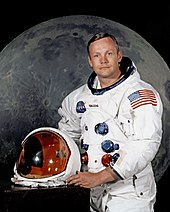
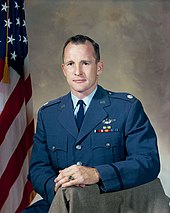
As its inaugural class in 1990, the Hall of Fame inducted the United States' original group of astronauts: the Mercury Seven. In addition to being the first American astronauts, they set several firsts in American spaceflight, both auspicious and tragic. Alan Shepard was the first American in space and later became one of the twelve people to walk on the Moon. John Glenn was the first American to orbit the Earth and after his induction went on, in 1998, to become the oldest man to fly in space, aged 77. Gus Grissom was the first American to fly in space twice and was the commander of the ill-fated Apollo 1, which resulted in the first astronaut deaths directly related to preparation for spaceflight.[9]
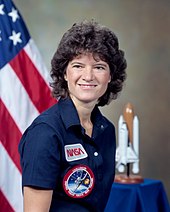
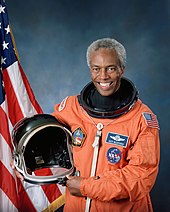
Thirteen astronauts from the
The third class was inducted in 1997 and consisted of the 24 additional Apollo,
The philosophy regarding the first three groups of inductees was that all astronauts who flew in NASA's "pioneering" programs (which would include Mercury, Gemini, Apollo, Apollo Applications Program (Skylab), and Apollo-Soyuz Test Project) would be included simply by virtue of their participation in a spaceflight in these early programs. The first group (the inaugural class of 1990) would only include the original Mercury astronauts (most of whom would go on to fly in later programs). The second group of inductees would include those astronauts who began their spaceflight careers during Gemini (all of whom would go on to fly in later programs). The third group of inductees would include those astronauts who began their spaceflight careers during Apollo, Skylab, and ASTP (some of whom would go on to fly in the Space Shuttle program). Since it would not be practical (or meaningful) to induct all astronauts who ever flew in space, all subsequent inductees (Space Shuttle program and beyond) are considered based on their accomplishments and contributions to the human spaceflight endeavor which would set them apart from their peers.
Over four dozen astronauts from the Space Shuttle program have been inducted since 2001. Among these are
The 2010 class consisted of
Those inducted in 2015 were
Michael López-Alegría, Scott Kelly and Pamela Melroy were the 2020 inductees, inducted in a November 2021 ceremony. The 2022 inductees were Christopher Ferguson, David Leestma, and Sandra Magnus. Roy Bridges Jr. and Mark Kelly were the 2023 inductees.[18]
Exhibits
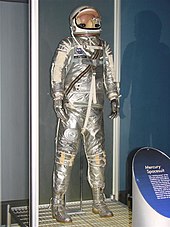
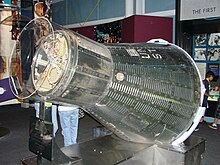
The Hall of Heroes is composed of tributes to the inductees. Among the Hall of Fame's displays is Sigma 7, the Mercury spacecraft piloted by Wally Schirra which orbited the Earth six times in 1962, and the Gemini 9A capsule flown by Gene Cernan and Thomas P. Stafford in 1966. An Astronaut Adventure room includes simulators for use by children.
The
Gallery
-
Alan Shepard's Apollo 14 lunar space suit
-
Replica of Apollo 15 Genesis Rock
-
AG5C spacesuit
-
Full-scale replica of a Space Shuttle orbiter which once stood adjacent to the United States Astronaut Hall of Fame
See also

- Kennedy Space Center Visitor Complex
- List of astronauts by year of selection for training
- Space Mirror Memorial
- US Space Walk of Fame
- International Space Hall of Fame
- List of aerospace museums
- North American aviation halls of fame
References
- ^ U.S. Astronaut Hall of Fame at Kennedy Space Center Visitor Complex Archived 2009-05-19 at the Wayback Machine, retrieved 2007-08-23
- ^ Jay Clarke (1990-10-30). "Mercury Museum -- Hall Of Fame Honors 7 Who Blazed A Trail In Space". The Seattle Times. Retrieved 2007-05-27.
- ^ Corey Schubert (2002-08-07). "Space Camp Florida Faces Foreclosure, Low Attendance Partly to Blame". Florida Today. Archived from the original on 2008-06-18. Retrieved 2007-05-27.
- ^ "Astronaut Hall of Fame Reopens to Public Saturday, Dec. 14 As Newest Attraction at Kennedy Space Center Visitor Complex". Kennedy Space Center Visitor Complex. 2002-12-14. Retrieved 2007-05-27.
- ^ Dean, James (January 15, 2016). "Shuttle model 'Inspiration' barging into new mission". Florida Today. Viera, FL. Retrieved January 26, 2021.
- ^ "U.S. Astronaut Hall of Fame closing soon for relocation". Florida Today. Retrieved 2018-07-28.
- ^ Emre Kelly (2020-07-17). "Lockheed Martin will lease former Astronaut Hall of Fame for NASA's Orion spacecraft". Florida Today. Retrieved 2020-09-15.
- ^ "Boeing Executive Inducted Into Astronaut Hall of Fame". The Boeing Company. 2004-05-04. Archived from the original on June 13, 2008. Retrieved 2007-05-27.
- ^ "Mercury Astronauts Dedicate Hall of Fame at Florida Site". Victoria Advocate. Victoria, Texas. Associated Press. May 12, 1990. p. 38 – via Newspapers.com.
- ^ Clark, Amy (March 14, 1993). "Activities Honor Gemini Astronauts". Florida Today. Cocoa, Florida. p. 41 – via Newspapers.com.
- ^ U.S. Astronaut Hall of Fame at KSC Visitor Complex - Astronaut Scholarship Foundation Archived 2009-05-19 at the Wayback Machine, United States Astronaut Hall of Fame, retrieved 2009-05-04
- ^ "2010 U.S. Astronaut Hall of Fame Induction Gala". Astronaut Scholarship Foundation. Archived from the original on May 1, 2010. Retrieved May 10, 2010.
- ^ "2011 U.S. Astronaut Hall of Fame Induction". Astronautscholarship.org. Archived from the original on 17 February 2011. Retrieved 10 August 2017.
- ^ "Astronaut Hall of Fame's new space shuttle inductees humbled by heroes' welcome - collectSPACE". collectSPACE.com. Retrieved 10 August 2017.
- ^ "Astronaut Hall of Fame adds space shuttle vets Brown, Collins and Dunbar" April 21, 2013 CollectSpace.com
- ^ "Astronaut Hall of Fame inducts two record-setting space shuttle fliers" May 4, 2013 CollectSpace.com
- ^ "U.S. Astronaut Hall of Fame Induction Ceremony & Gala". Retrieved February 22, 2017.
- ^ NASA article on the 2023 inductees
- ^ John Kelly (2002-11-20). "Gus Grissom's Family, NASA Fight Over Spacesuit". Florida Today. Retrieved 2007-05-27.
- ^ "NASA, Astronaut's Family Fight Over a Spacesuit". The Washington Post. 2002-11-30. Retrieved 2007-05-04.
- ^ Christopher Lee (2005-08-24). "Grissom Spacesuit in Tug of War". Washington Post. Retrieved 2007-05-27.





